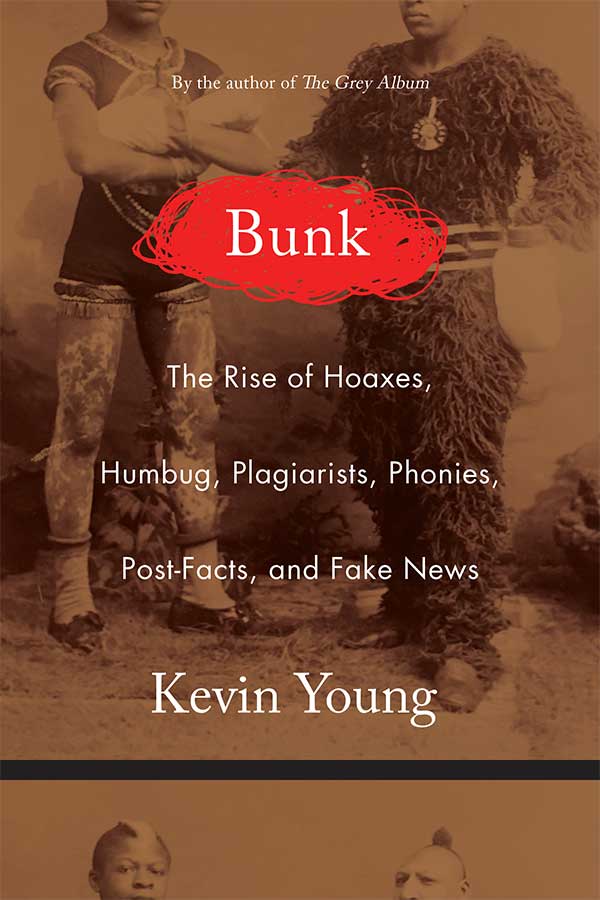The Conventionalist

Young reveals the barrel is filled with snake oil from the top down, starting with the literary crowd.
FOR A YEAR, I have been subtitling books without their permission. I do it invisibly so that the covers aren’t harmed. In my mind, after the colon, I see: A Story of How We Wound Up With Trump.
The genre and plot are immaterial. Short grit-speckled stories set in Appalachia? Definitely A Story of How We Wound Up With Trump. A memoir about growing up with a Catholic priest for a father? Definitely A Story, probably How. Historical fiction about worker strikes in Italian factories? Very How, somehow.
Kevin Young’s new book has a better subtitle. When it comes to every work of art I’ve experienced in the past year, Young has a better everything. The best lines in this review will be those from Young’s Bunk: The Rise of Hoaxes, Humbug, Plagiarists, Phonies, Post-Facts, and Fake News, which reminds readers that there’s nothing new about our current informational hellscape. To Young, a National Book Award-winning poet as well as the poetry editor of The New Yorker, deception is as central to American life as “with liberty and justice for all,” which itself is a deception. Young categorizes and sub-categorizes various strands of phony hoaxery, noting how they recur across the decades with startling similarity. The penny press seeks to democratize information and instead sensationalizes and distorts every sentence of the news; the internet says “hold my beer.” P.T. Barnum tours George Washington’s 161-year-old nursemaid and casts the audience as the reality expert, asking them to “come see and decide for yourself;” reality television gives you a group of singers and a number to call, casting “everyone a judge.”
Young does not interrogate only the bottom of the cultural barrel. In fact, he shows that the barrel is pretty much filled with snake oil from the top down, starting with the literary crowd. Edgar Allen Poe’s only novel, in which “one-fifth of the entire book came from elsewhere,” provides something of a template for future plagiarists and hucksters like JT Leroy, Jayson Blair, and James Frey, all of whom are recounted in detail. “Scratch a hoaxer,” Young writes, “you often sniff a plagiarist.”
Bunk is researched and then some. In the wrong hands, this mountain of research could be deployed for show-offy purposes, but Young is deft. He doesn’t always go all-in. One of his most effective techniques is his reliance on analogies and metaphors that point toward other examples of American informational mischief. For instance, when providing a crash course on the history of “touching up” photos, Young briefly, with no further elaboration, likens the photograph in question to “the way Time also darkened O.J. Simpson’s face and mug shot after his arrest in 1994.”
There could be an entire book about this O.J. example—context, interviews, aftermath. There probably is. But the fly-by pace creates the sense that “O.J.: The Darkening” was one example chosen from a box of thousands. Sometimes the fly-by’s are historical. Sometimes they are semiotic. A brief exploration of the word Caucasian reveals the utter meaningless of the word. Young suggests that to “avoid using it, as I have learned, is to understand where words and people actually come from.”
“Every hoaxer is dependent on a hoaxee, and a hoaxee’s interpretations are not issued from a vacuum.”
Note that “I.” Bunk is not dryly written history. A slight revision: eventually, Bunk is not dryly written history. For the most part, Young doesn’t insert his voice all that much alongside the early narratives of historical figures like Barnum. But gradually, as the narrative syncs with Young’s life, he begins to assert something of a writerly persona. He enters the text. Sometimes, it’s purely for laughs. A long block quote receives the following analysis as a cap: “you’re right, Steve, I don’t believe it.” In other moments, the writing becomes downright memoiristic (this in a book that seriously questions memoir as a genre). Young describes his zip code in 1992:
“San Francisco was the kind of place where a weekday matinee for Richard Linklater’s Slackers was totally packed. You could see acid jazz five nights a week, and hip-hop almost as much; sushi was a fast food and if you shot pool you had to obey unwritten rules: No Slop. You had to call it. Few young folks got a job then in yet another recession, so why not live where you wanted, if not how, and work somewhere while finding your way? Back there and then you could easily meet people but not always get to know them.”
This type of scene-setting matters. Every hoaxer is dependent on a hoaxee, and a hoaxee’s interpretations are not issued from a vacuum. The hoaxee brings their own cultural baggage and influences to an interpretation, and by pausing every so often to recount his own cultural environment, Young helps establish the lens through which he viewed events in real-time—namely, from a place of both personal skepticism and eroding cultural vigilance. The more personal sections are inviting. At times, they are funny. Even at the end of certain chapters, when the writing verges toward cheesiness—“an American cocktail of doubt and danger, desire and delight”—it’s easy to read these lines as working inside the genre of the hoaxers. It’s a riff. It’s fun.
The coda is not. It addresses the modern presidential Barnum, who floats throughout the book in stated and unstated ways like a lumpy marmalade ghost. The Trump presidency may single-handedly keep the magazine and publishing world solvent, what with the cottage industry of cultural criticism it has produced, and Young’s final chapter belongs on any “Best of” list. The bit about Trump the candidate promising not “freedom for but freedom from [reality]” is one of the most clearly and artfully worded paragraphs that has been written about the administration. The closing observation about truth as a muscle should be referenced in every commencement speech this coming spring. It strikes me that I’m verging toward vagueness. I’m quoting less than usual. It’s quite a structural feat he pulls off in the coda, and like Young’s subjects, I hereby promote the experience over any explanation.
Patrick McGinty’s fiction has appeared, most recently, in ZYZZYVA and The Portland Review. He recently wrote about Jon McGregor’s “Reservoir 13.”
